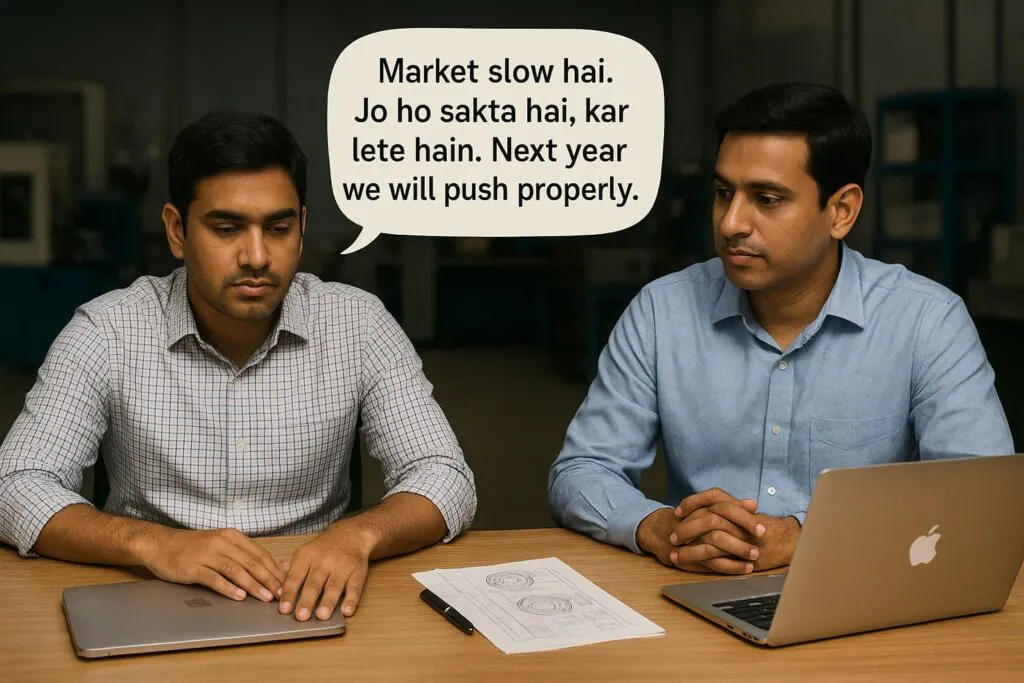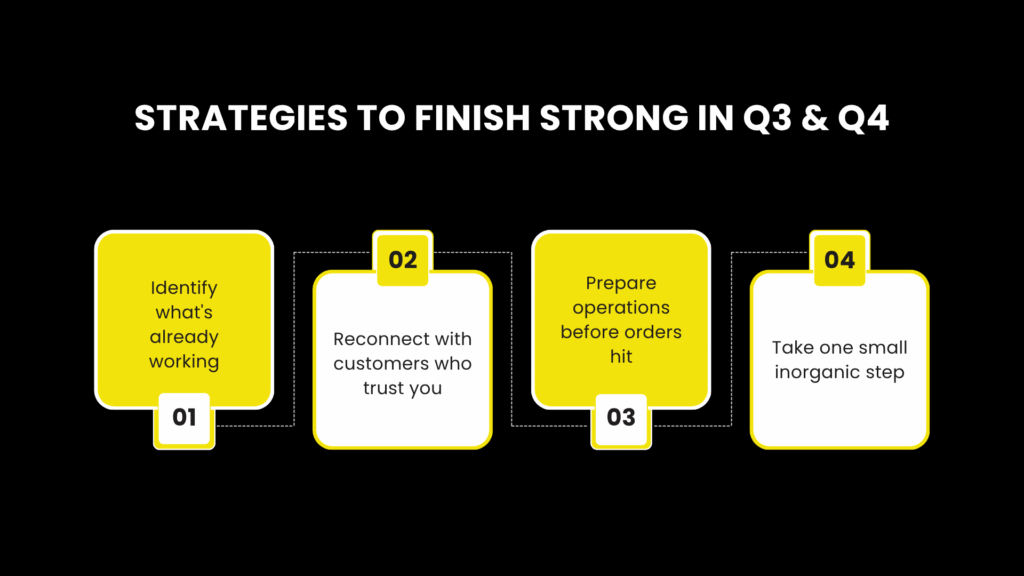1st April 2025. If you’re an SME entrepreneur, you probably built a Vision and Goals for this year. If yes only then read further.
Answer a few quick questions:
- Do you still remember your goal?
- Do you think it will not be easily achievable?
- Most probably, you will miss it?
- Does it feel impossible to fulfil now?
- Is it “high time” to think inorganic to hit your goal?
If your answer is yes to most of these, this blog is worth your 7 minutes.
Otherwise, you’ll likely say the familiar line: “इस साल जितना हो जाए, उतना ठीक है”
A quiet shift that changes everything
Most years don’t fail because the market is dead. They slow down because the mindset quietly shifts from “we will achieve it” to “जो हो सकता है, वो कर लेते हैं” That one mental switch lowers the energy of the whole organisation.
But here’s what most businesses forget:
India’s strongest business season begins now in the last 150 days. The period when demand spikes, customers decide faster, and budgets get used up before March 31.
“Excellence happens not by accident. It is a process.” – Dr. A.P.J. Abdul Kalam
(Exactly why Q3–Q4 discipline matters.)
Why these last 150 days matter more than the first seven months
India runs on a unique rhythm and the second half is where the action is.
- Festive season drives 25%–40% of annual revenue across many SME-linked sectors (retail, textiles, consumer goods, manufacturing supply chains). This is also reflected in record e-commerce GMV during festive windows (overall festive GMV expected ₹1.15 lakh crore+, up 20–25% YoY).
- October 2025 GST hit ₹1.96 lakh crore fresh festive-season high evidence of real transactions flowing through the economy.
- India’s digital payment rails are on fire: UPI clocked 20.7 billion transactions worth ₹27.28 lakh crore in Oct 2025, a demand and velocity signal you cannot ignore.
- Domestic order optimism improved into Q4 even as global headlines remained mixed telling you Indian demand pockets are alive if you show up with focus.
- Lenders and fintechs report festive-season MSME credit surges (projections around +40%) working capital is available if your demand is real.
- As per one survey: customers in Q3 and Q4 take 45% faster decisions than in Q1 and Q2.
“What gets measured gets managed.” – Peter Drucker
(Q3–Q4 wins come from weekly tracking of offers, pipeline, OTIF, and collections.)
What We Saw in One Assignment Last Year - It May Sound Familiar to You
In October 2024, we were working with a mid-sized manufacturing company. A steady business. 150 workers. Known in the market. Not struggling, not booming just like many SMEs.

During one discussion, the owner leaned back and said:
“Market slow hai. Jo ho sakta hai, kar lete hai. Next year we will push properly.”
He wasn’t frustrated. He was simply tired.
When you put in effort for months and you don’t see the expected results, your mind naturally shifts to survival mode instead of growth mode.
This is exactly where many SMEs slow down. Not because market demand has ended, but because the belief to chase the target starts reducing.
So instead of telling him to “stay motivated” or “push harder”, we did something more practical: We reviewed what was already working.
What We Found
- 3 products were consistently getting orders even in a slow market.
- 2 regions were still responding well to follow-ups.
- Old customers hadn’t been contacted not because they weren’t interested, but because the team was absorbed in daily firefighting.
- The sales team was active, but everyone was working in different directions.
The problem was not sales. The problem was scattered effort.
What We Changed (Simple. Practical. Realistic.)
- Started one small Monday “Clarity Meeting” each week 15 minutes → One direction → One weekly priority.
- Shifted focus to fast-moving, high-margin products instead of pushing the entire product list.
- Reconnected with old customers and strong past buyers, not with discount offers,
but with clear delivery commitment and reliability. - Production was scheduled only for confirmed and high-probability orders, not based on assumptions or pressure.
No extra hiring.
No large marketing campaign.
No big restructuring.
Just clarity → alignment → disciplined follow-through.
What Happened Over the Next 150 Days

- Dispatch volumes grew by 38%
- Collections became smoother and faster
- Team energy and ownership came back
- And the annual target was achieved without adding manpower or increasing cost
The result did not come from “working harder”. It came from working in one direction.
The owner made one decision, Not to close the year early. And the year responded.
Strategies to finish strong in Q3 & Q4 (use now)

1) Identify what’s already working
Every SME has a natural 20% that drives 80% results. Find it.
- Prioritise manpower and stock on high-rotation SKUs
- Make your offer architecture simple: Foot-in-the-door → Core → Add-on
- Kill the noise if it doesn’t move now, pause it till April
“The successful warrior is the average man, with laser-like focus.” – Bruce Lee
2) Reconnect with customers who trust you
Old relationships buy faster than fresh prospects.
- Reopen old quotations with sharper delivery clarity
- Run a “we’re present” follow-up sprint for 10 working days
- Move from “price talk” to “speed + reliability” talk
“People do business with those they trust, not those who are the cheapest.”
3) Prepare operations before orders hit
Reputation is decided by dispatch, not by pitch.
- Lock raw material buffers for fast movers
- Pre-align supplier lead times and dispatch windows
- Tighten quality discipline and OTIF as a non-negotiable
4) If Needed, Take One Small Inorganic Step – Not a Big Jump
Q3–Q4 is the safest time to experiment because market flow supports correction.
- Add one new region
- Onboard one new dealer
- Launch one product variant
- Run one short-term offer for Q4 closures
Why only one?
Because Q3–Q4 is a momentum market. It will support corrections if needed but only if the experiment is controlled.
“Progress often comes from one good adjustment, not twenty changes.”
Pause for a moment and reflect:
- Which 2–3 products are your real growth engines?
- Which customers will respond first if you call today?
- Where does execution slow down inside your team?
- What will change if your whole business works in one clear direction for the next 150 days?
Your answers are already inside your business. They just need clarity and alignment.
Picture Abhi Baki Hai, Mere Dost.
This is not the time to slow down. The market activity is still strong, decisions are faster, and customers are willing to close. The remaining 150 days are where most SMEs actually complete a major portion of their yearly performance.

Your team has the capability. Your business has market presence. What is needed now is clear direction and consistent follow-through.
Communicate one message to your team:
“The target is still achievable. We will finish this year with focus.”
Lead with clarity.
Stratefix, Your Friend is There as a Backbone to Achieve This
At Stratefix, we support business owners exactly in this phase not with presentations, but by working with your team, simplifying priorities, building weekly execution rhythm, and restoring momentum. Because when focus returns, results accelerate.
If you feel this is the right time to realign and push ahead, we are here on the ground, with your people, ensuring execution becomes real.






